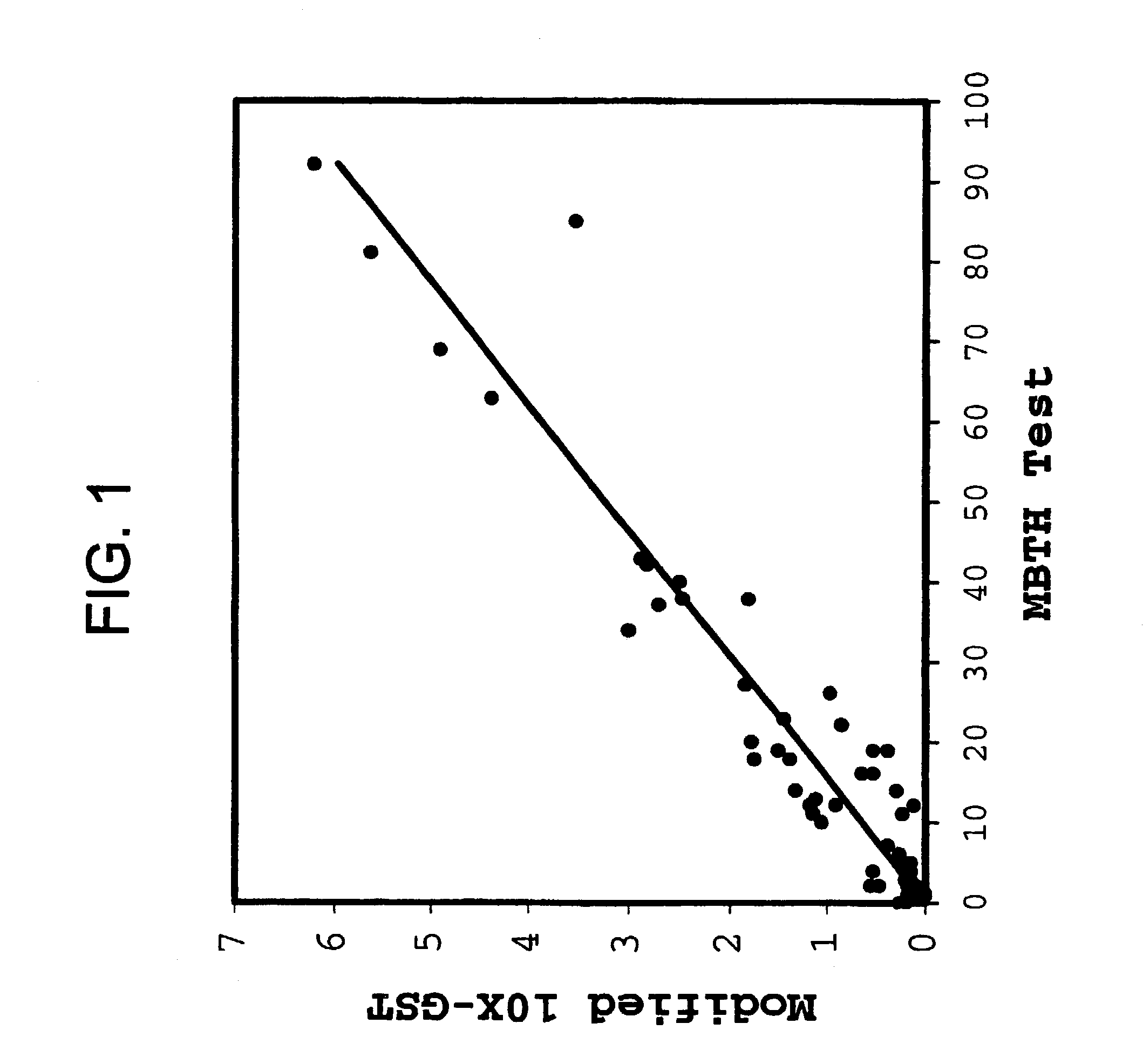Polypeptide compositions with improved stability
a polypeptide and stability technology, applied in the field of human medicine, can solve the problems of physical instability precluding the use of salts for isotonicity, lack of simple but accurate assay, and contribute to chemical instability of polypeptide products, so as to improve the chemical improve the stability of the composition, and reduce the level of covalently crosslinked polypeptides
- Summary
- Abstract
- Description
- Claims
- Application Information
AI Technical Summary
Benefits of technology
Problems solved by technology
Method used
Image
Examples
example 1
Selectivity of Aldehyde Tests
[0158]A sample of plant-derived glycerin was spiked with defined levels of aldehydes shown in Table 1. The spiked glycerin samples were then assayed by the MBTH Test described herein (Method 1) and three other tests.
[0159]For the “Nash” test, aldehydes in the glycerin were extracted into pH 7.5 phosphate buffer and then derivatized with acetylacetone in the presence of excess ammonium acetate [du Chatinier, et al., Analytical Letters 22:875–883 (1989)]. The colored reaction products were quantified at 415 nm using a spectrophotometer.
[0160]For the “Purpald” test, the reagent 4-amino-3-hydrazino-5-mercapto-1,2,4-triazole [Aldrich Chemical Company] was dissolved in 1 N NaOH. This solution was then added to glycerin solutions that had been diluted with water. After aeration, the absorbances of the solutions at 401 nm were determined using a spectrophotometer.
[0161]For the European Pharmacopoeia (Ph. Eur.) test, the glycerin solutions were mixed with pararos...
example 2
Correlation of MBTH Test with the Modified 10×-GST Test
[0166]The reactive aldehyde content of fresh and aged commercial lots of glycerin was measured by the MBTH Test described herein. Each sample of glycerin was also evaluated using the Modified 10×-GST Test (Method 3). For the combined propylene and plant-derived glycerin samples (n=39, and n=25, respectively) the results displayed in FIG. 1 show a strong, linear correlation (R2=0.90, for the best fit line forced through the origin) between the reactive aldehyde content as measured by the MBTH Test (2=0.93, data not shown).
example 3
Reactive Aldehyde Content of Aged Commercial Glycerin Lots
[0167]Commercial lots of glycerin whose dates of manufacture were known were stored at ambient temperature for 1 to 48 months from their dates of manufacture. For each lot of glycerin, the reactive aldehyde content was measured by the MBTH Test described herein. Data from these lots are shown in Table 2 below.
[0168]
TABLE 2Analyses of Reactive Aldehyde inGlycerin Lots Derived from Three SourcesAnimalPlantPropyleneLots Analyzed6 10 36 Age Range 3–47 1–291.5–48 (months)Average Age22.010.619.9(months)Aldehyde Range 24–1069 4–43 0–169(ppm)Aldehyde Average301.5 ± 162.523.6 ± 4.5 25.2 ± 6.2 (ppm ± SEM)Aldehyde Average13.7 2.2 1.3per Average Age(ppm / month)Average of Lot16.5 ± 7.1*3.6 ± 1.3*Aldehyde perMonth of Age(ppm ± SEM)SEM = standard error of the mean*statistically different, p = 0.003 calculated by Wilcoxon Rank-Sum Test
[0169]These data clearly show that aged glycerin lots derived from propylene and plants have a lower range ...
PUM
| Property | Measurement | Unit |
|---|---|---|
| concentration | aaaaa | aaaaa |
| concentration | aaaaa | aaaaa |
| concentration | aaaaa | aaaaa |
Abstract
Description
Claims
Application Information
 Login to View More
Login to View More - R&D
- Intellectual Property
- Life Sciences
- Materials
- Tech Scout
- Unparalleled Data Quality
- Higher Quality Content
- 60% Fewer Hallucinations
Browse by: Latest US Patents, China's latest patents, Technical Efficacy Thesaurus, Application Domain, Technology Topic, Popular Technical Reports.
© 2025 PatSnap. All rights reserved.Legal|Privacy policy|Modern Slavery Act Transparency Statement|Sitemap|About US| Contact US: help@patsnap.com

